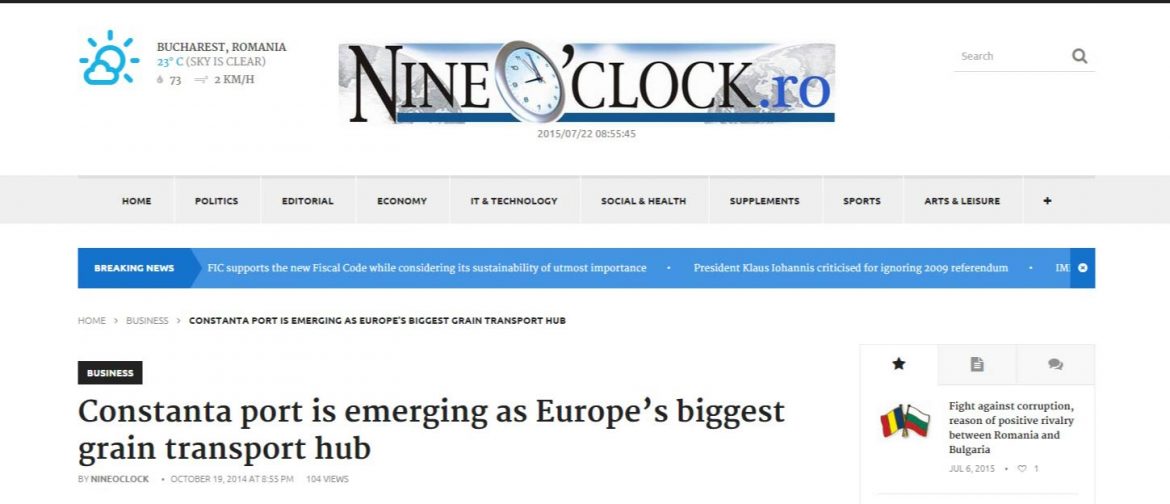Nineoclock Business
Nineoclock Business www.nineoclock.ro
October 19, 2014
Link to article
Constanta port is emerging as Europe’s biggest grain transport hub in the $4.2 billion global wheat trade, according Bloomberg.
Buoyed by booming wheat and corn exports from Romania and its neighbors to the Middle East, grain volume passing through the port was up 30 percent by August from a year earlier and will top last year’s record by year end, according to port spokeswoman Monica Velicu. Cargill Inc., the largest closely held U.S. company, and freight handler Transport Trade Services SA more than doubled grain capacity at their Canopus Star terminal at Constanta in August.
Shippers sent a record 533 Panamaxes and other dry bulk carriers to Constanta’s deep-water berths in 2013, a 21 percent increase from the previous year, port data show. Rising crop yields in Romania,Bulgaria and Hungary, along with new silos and terminals to handle the growing grain flow to Egypt, have vaulted the port ahead of Rouen, France as Europe’s grain hub.
Output of grains has gradually increased in Romania, Bulgaria, Hungary and Serbia, James Hyslop, director for Romania at the European Bank for Reconstruction & Development, said in an e-mailed reply to questions on Oct. 9. Constanta port was the main facility to benefit. It’s the only large port with sufficient capacity to serve the region.
Constanta handled 9.5 million tons of grain through August, up 30 percent from 7.3 million tons a year earlier. Volume will top last year’s record 15.3 million tons by year end, according to Velic. Wheat futures traded in Paris dropped 22 percent this year on plentiful supplies.
The Romanian port exported 8.7 million tons of grain last year, up from 5.39 million in 2012. Rouen, France’s busiest grain hub, exported 7.35 million tons in 2013, compared with 5.45 million tons the prior year, port data show.
Grain exports will only continue to grow, said Peter Beerents, chief executive officer of Cibus Farmland Club, a Dutch adviser setting up its third Romanian farm for family investors. This is a land with a lot of natural riches.
Constanta has an edge getting to the Egyptian grain market, the world’s biggest. Egypt’s grain port of El Dekheila is a trip of 1,188 nautical miles, or 3.5 days at sea at an average 14 knots, according toports.com. That compares to 1,393 nautical miles from Odessa and 1,576 nautical miles from Russia’s Black Sea port of Novorossiysk, trips of 4.1 and 4.7 days.
Constanta ranked as the EU’s ninth-biggest dry bulk port by tonnage in 2012, behind Italy’s Taranto and the Belgian port of Antwerp, Eurostat data show. Rotterdam led the list.
Romania’s rising grain exports and improving logistics have coincided with rising investment by Cargill, ADM and CHS, all of which own or have stakes in Constanta grain-export terminals, according to the port. ADM is the world’s largest corn processor, and CHS is the largest U.S. grain cooperative.
The Port of Constanta is located at the crossroads of the trade routes linking the markets of the landlocked European countries to Transcaucasus, Central Asia and the Far East. The port has excellent connections with the Central and Eastern European countries through the Corridor IV (rail and road), Corridor VII Danube (inland waterway), to which it is linked by the Danube-Black Sea Canal, and Corridor IX (road), which passes through Bucharest. The two satellite ports Midia and Mangalia that are located not far from Constanta Port are part of the Romanian maritime port system under the coordination of Maritime Ports Administration SA Constanta.
The Port of Constanta is one of the main distribution centers for the Central and Eastern Europe, offering many advantages, of which mention must be made of:
* Multi-purpose port with modern facilities and sufficient water depths in the port basins to accommodate the largest vessels passing through the Suez Canal;
* Direct access to the Central and Eastern European countries through the Pan-European Corridor VII the Danube;
* A hub for the container traffic in the Black Sea;
*Good connections with all modes of transport: railway, road, river, airway and pipelines;
*Customs facilitations for commercial operations performed through the Port of Constanta;
*Modern facilities for passenger vessels;
* Land availability for future expansion;
* Since 1st January 2007, the Port of Constanta has become Free Zone.


